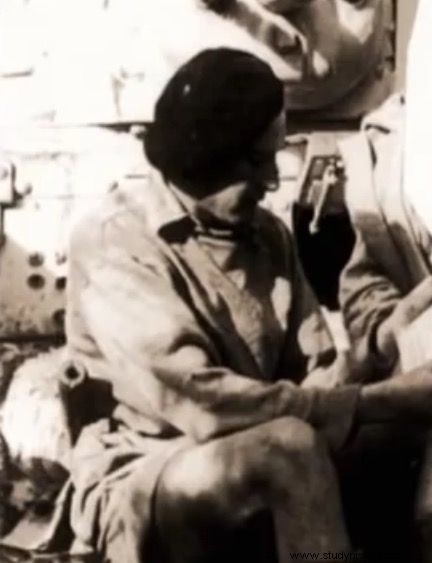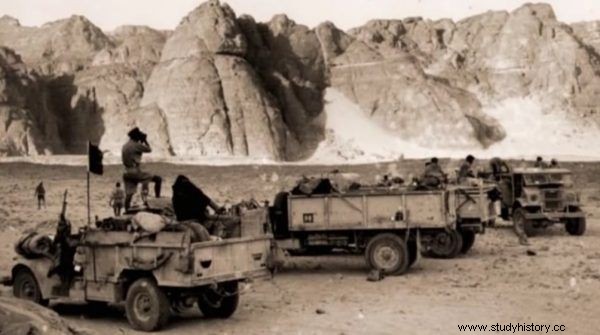They lied compulsively, spoke several languages, and the tan was part of the camouflage. They did not command large armies, rarely took part in open duels of powerful divisions, but they often traversed hundreds of kilometers of the desert alone. Not only Erwin Rommel earned the nickname "the fox of the desert".
Although Erwin Rommel was unanimously hailed as the "Desert Fox" during the campaign in Africa during World War II, the nickname could well have been shared by a few British soldiers. Today they are remembered only by a long and silent list of Military Cross Knights .
"Fox" dressed as Arab
It is difficult not to give the field marshal what is "field marshal", but in the activities on the front line Erwin Rommel was far from the seemingly Bedouin captain of the Intelligence Corps and Special Operations Command. John Edward Haselden grew up in Egypt, although his family never let him forget his British roots. But he was not your typical gentleman drinking tea every day at 5:00 pm, thanks to the "explosive mixture" flowing in his blood. Haselden's mother was an Italian beauty, Maria Ester Cazzani, from whom he was to inherit primarily a dark complexion - so important during his activities in intelligence. He knew at least two Arabic dialects, and was also fluent in French, German and Italian. With time, he even made an attempt to learn one of the Slavic languages (mainly thanks to his Polish-Italian wife - Nadia Szymonski-Lubicz). Haselden quickly became a legendary figure among British soldiers fighting in Africa.
He was often given the nickname of "Lawrence of World War II", which, by the way, did not differ much from the occupation of the hero of the First World War. His ability to win over the Arab tribes allowed him to conduct intelligence activities, going deep into enemy territory, where after a few weeks he was picked up by LRDG patrols. His sheep grazing at the Italian airport must have gone down in legend . The "Arab", undisturbed by anyone, walked for several hours between the enemy planes, listening to the increasingly louder laughter of Italian soldiers who suspected him of the lost goats rather than taking notes for British intelligence. In November 1941 he was commissioned to "hunt" the real "Desert Fox" - Erwin Rommel. Haselden was to track him down at a residence in Beda Littoria. The Bedouin ace of intelligence "picked up" from the beach of Chescem el-Kelb (Libya) a unit commanded by Lieutenant Colonel Goeggrey Keyes and led the commandos behind enemy lines almost to the door of the Field Marshal's residence. Although Operation Flipper ended in a total disaster (mainly due to the fact that Rommel was not even in Africa that night), Haselden was recognized with the Military Cross for his many weeks of service deep in enemy-controlled territory (he covered almost 160 km on foot in the desert).

"Buck" - Capt. Henry Cecil Buck during the LRDG patrol standstill
"Foxes" in a German cap
His name was Henry Cecil Buck and he was the captain of the 5th battalion of the 1st Punjab Regiment. He spent most of his childhood in India, where he received an elementary education. However, he finished his studies in political science, economics and philosophy at Oxford, and then shortly before 1940 he was assigned to the Indian regiment. Apparently, he never "managed to develop military qualities", let alone the characteristics of an officer in the British army. Already during the war, Buck was wounded at El Gazala and was captured. However, he managed to escape using the poor construction of the walls of the camp laundry room. For the next week, together with a companion of captive misery - John McKee - they made their way through the desert to finally steal a German truck and, in a hostile uniform, break through to the mother lines.
Buck knew the German language very well, and also mastered basic Arabic phrases, thanks to which contacts with the local population or German patrols did not cause him major problems and allowed him to successfully implement the escape plan. The British patrol, which finally stopped the "German" truck after almost a month, could not help but admire Buck's bold, consistent and ingenious action. It was recommended to create one of the most elite units of World War II - SIG (Special Interrogation Group). It was a unit known as "suicides" - German Jews largely from Palestine, whose tasks were to penetrate deep behind enemy lines and carry out subversive actions.
Recruitment for "suicides"
The preconditions for falling under Buck's orders were German-Jewish descent, and a deep hatred of the Third Reich . The training required even more from the candidates. For this purpose, an isolated training center was created for them on the shores of the Bitter Lakes, where Buck's agents could not be exposed to British influences from LRDG or SAS soldiers. German alone was not enough here. SIG agents had to flawlessly use the slang of Afrika Korps soldiers . For the perfectionist Buck, even the slightest deviation from the norm in the march was a signal that a given candidate could put an entire squad to death. He taught his subordinates over time to sleep like German soldiers, march like German soldiers, think in German and even write letters to non-existent women in Berlin.

"SIG" - SIG branch, one of the last photos before the attack on Tobruk
A special gift from the creator of the new unit for his subordinates was German, dark chocolate, cigarettes, but also heavily used (often not very well smelling) underwear characteristic for Afrika Korps soldiers . Every morning Buck's soldiers were woken up by the command of Kompanie aufstehen after which each of them, "in larks", sang German war songs under his breath. The most murderous, however, was learning to "sleep in German". Buck was concerned that a SIG agent might utter a few uncoordinated words in English while he slept, so to that end he would often sit by the beds of his subordinates for hours at night, waiting for words in a forbidden language. The agent did not undergo the final verification until he was in a British POW camp, staying among native Germans and Italians. The best counterfeiters in British intelligence worked for SIG, who forged paybooks, family letters, IDs and photos of girls - all this to maintain the status quo as long as possible in the event of disclosure. In the event of disclosure, they were probably threatened with immediate execution, or death after a short interrogation. No wonder, because in reality they were just traitors.
"Agreement"
On June 21, 1942, SAS and SIG soldiers were in the Siwa oasis when they received information about the fall of the Allied garrison in Tobruk - one of the most important Mediterranean ports of World War II. Haselden and the Long Range Desert Group decided to implement a long-standing plan - to conquer Tobruk by acting from the inside. Nothing easier - to break into the city in the "Trojan horse" and then, under the cover of night, murder the enemy's defense . In mid-August, after weeks of preparations, John Haselden became the commander of the undertaking, and the operation itself was approved and codenamed "Agreement". The deadline for the implementation of the project, by which the Allies were to retaliate against the Axis troops, was set for September 13, 1942. As a result, the Agreement was a collection of several smaller land and naval operations, such as Operation Bigamy and Operation Caravan. Haselden and SIG agents assumed that there should be over 30,000 British prisoners of war in the city itself, which they intended to use for further fighting inside the fortress. The plan seemed to be seemingly unusually audacious. SIG agents will bring SAS troops into the city driving in "captured" (properly marked) British trucks. They will then capture key bridgeheads within the city itself and expect strikes from sea and land. At 9:30 p.m. on September 12, the bombing began. Until the morning hours of September 13, there were fights for the city, which the Germans did not want to give up for anything. The trick with fake Afrika Korps trucks failed the test and the soldiers were spotted relatively quickly. The Germans also managed to sink the destroyers "Sikh" and "Zulu" - the planned escape route for commandos. In this atmosphere, enthusiastic Haselden was fatally wounded by machine gun fire.
Although SAS soldiers made two attempts to take his body with them, they eventually had to abandon the idea. Six soldiers returned from a group of several dozen "suicides" from Tobruk, and the city itself remained in the hands of Rommel.
